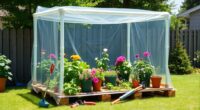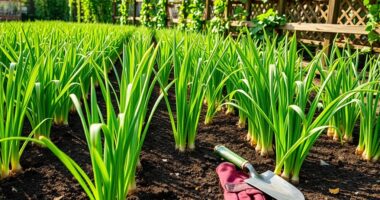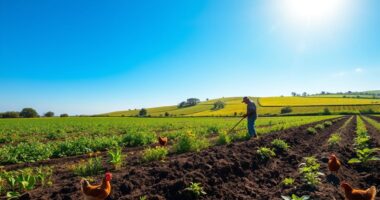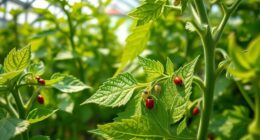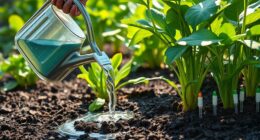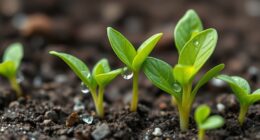When optimizing your greenhouse, I’ve found that selecting the right sensor technologies is essential. Devices like the HT1 Smart Temperature and Humidity Sensor and Govee Bluetooth Indoor Hygrometer provide accurate data for ideal plant growth. With options like the ThermoPro and solar-powered window openers, you can monitor and adjust your environment effectively. Understanding key factors like connectivity, battery life, and precision can really enhance your growing experience. Stick around, and I’ll share even more tips to boost your greenhouse success!
Key Takeaways
- Utilize smart temperature and humidity sensors to ensure optimal growth conditions, with high accuracy and convenient data logging features.
- Opt for Bluetooth or WiFi-enabled sensors for real-time monitoring and easier access to data from remote locations.
- Choose sensors with long battery life (1-2 years) to reduce maintenance and ensure consistent data collection for greenhouse conditions.
- Look for devices with quick refresh rates and calibration features to maintain accuracy in temperature and humidity readings.
- Consider environmental suitability, ensuring sensors can operate effectively across a wide temperature range and withstand greenhouse conditions.
HT1 Smart Temperature and Humidity Sensor
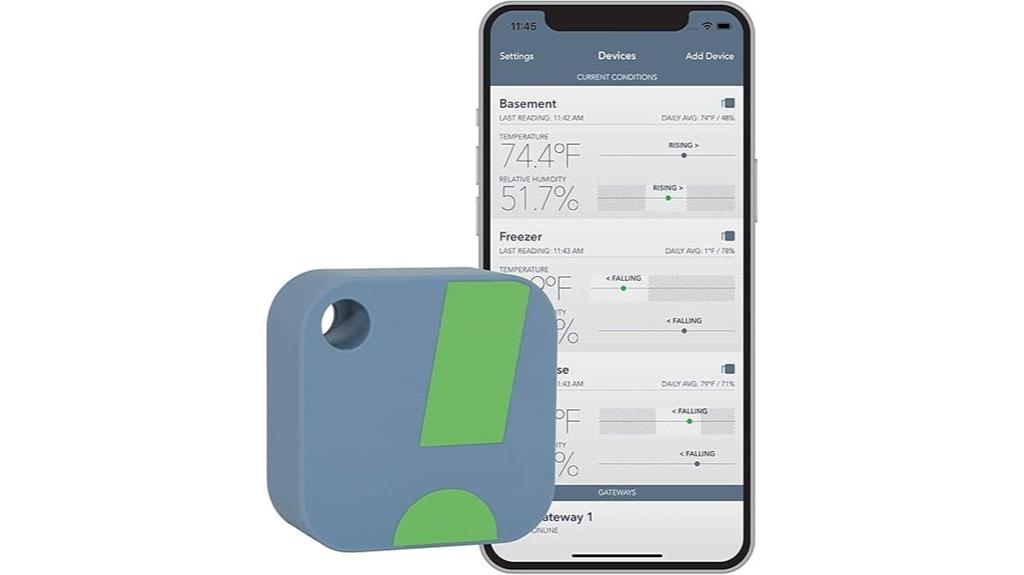
If you’re looking for a reliable way to monitor temperature and humidity in your greenhouse, the HT1 Smart Temperature and Humidity Sensor is a standout choice. I love how it connects via Bluetooth, giving me a 100-meter range without complicated installation. It records data for 20 days and stores it endlessly in the app, which is super handy. Its high accuracy guarantees my plants thrive, and I appreciate the intuitive setup. While it lacks smart home integration, its performance and excellent customer support make it a top pick. Overall, it’s a dependable tool for maintaining the perfect growing environment.
Best For: The HT1 Smart Temperature and Humidity Sensor is best for greenhouse owners and hobbyists who need a reliable and easy-to-use tool for monitoring environmental conditions.
Pros:
- High accuracy within 1% rH and 2°F, ensuring optimal conditions for plant growth.
- User-friendly setup and intuitive app interface make it accessible for all users.
- Long battery life averaging 1-2 years under typical conditions, reducing maintenance needs.
Cons:
- Lack of smart home integration with systems like Alexa and Google Home may limit automation options.
- Battery type (CR2477) can be costly and not widely available for replacement.
- Cannot be turned off without removing the battery, which may be inconvenient for some users.
Govee Bluetooth Indoor Hygrometer Thermometer (H5075)
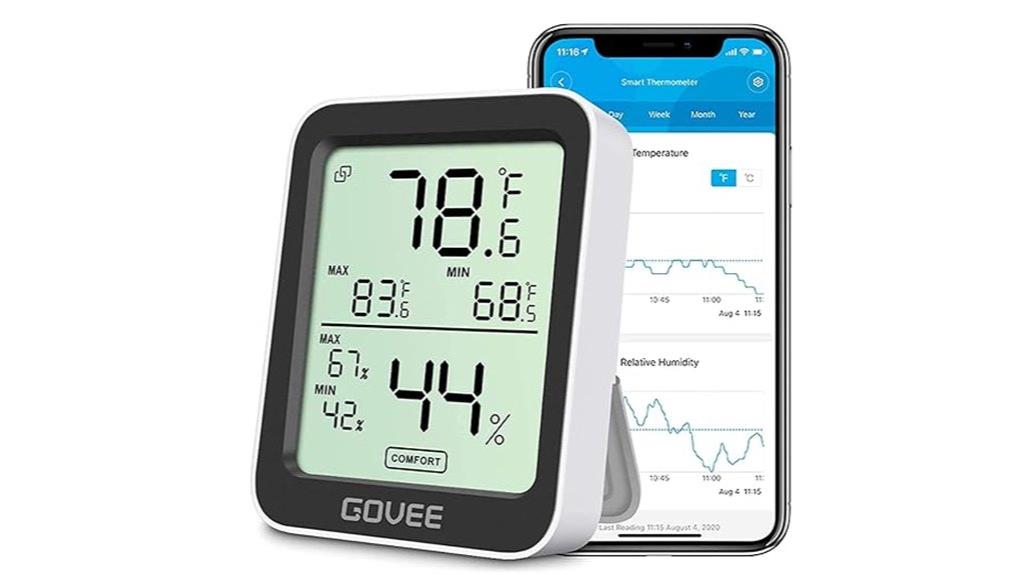
The Govee Bluetooth Indoor Hygrometer Thermometer (H5075) stands out as an excellent choice for greenhouse enthusiasts due to its high accuracy and real-time monitoring capabilities. With temperature readings accurate to ±0.54°F and humidity to ±3%RH, it refreshes data every 2 seconds. The user-friendly Govee Home app allows me to monitor conditions remotely and receive alerts when levels exceed my set ranges. I love the 3-inch LCD screen, which displays max/min records and comfort indicators. The setup is a breeze, requiring just AAA batteries, making it perfect for tracking my greenhouse environment effortlessly.
Best For: The Govee Bluetooth Indoor Hygrometer Thermometer (H5075) is best for greenhouse enthusiasts and individuals seeking precise indoor climate monitoring.
Pros:
- High Accuracy: Provides temperature readings accurate to ±0.54°F and humidity to ±3%RH.
- User-Friendly App: The Govee Home app allows for remote monitoring, instant alerts, and historical data access.
- Easy Setup: Requires only AAA batteries for a straightforward setup process.
Cons:
- Bluetooth Connectivity Issues: Some users experience intermittent connectivity problems.
- Limited Display Size: The 3-inch LCD screen may be too small for some users to read comfortably from a distance.
- Dependence on Batteries: The device requires battery replacements, which may be inconvenient for continuous use.
ThermoPro Hygrometer Thermometer for House (TP350)
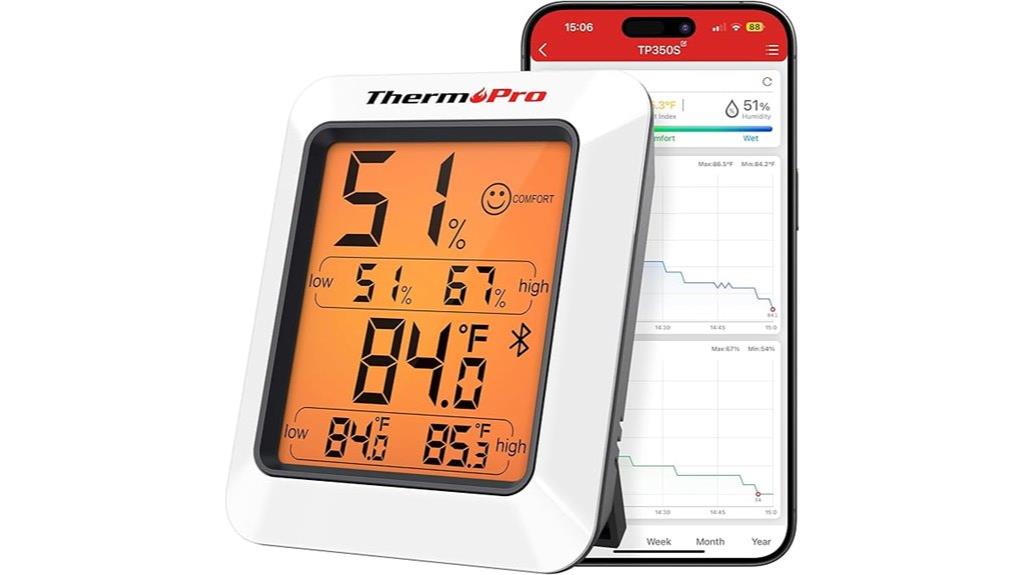
For anyone looking to optimize their greenhouse environment, the ThermoPro TP350 stands out with its impressive Bluetooth range of up to 260 feet. I love how this hygrometer thermometer tracks temperature and humidity with high accuracy. Its backlit display is perfect for low-light conditions, and I can easily switch between Celsius and Fahrenheit. The device’s app lets me monitor conditions remotely and even set alerts, ensuring I can make timely adjustments. Plus, its compact design means I can place it anywhere. With a two-year data storage, it’s a fantastic tool for anyone serious about maintaining the ideal growing environment.
Best For: The ThermoPro TP350 is best for greenhouse enthusiasts and anyone looking to optimize indoor climate conditions.
Pros:
- Accurate temperature and humidity readings with a refresh rate of 10 seconds.
- Remote monitoring and alert settings via a user-friendly app.
- Compact design allows for versatile placement options.
Cons:
- Bluetooth range may be limited by physical obstructions.
- App functionality might be too basic for advanced users seeking more features.
- Battery life may vary depending on usage and environmental factors.
Indoor Outdoor Wireless Thermometer with Digital Hygrometer
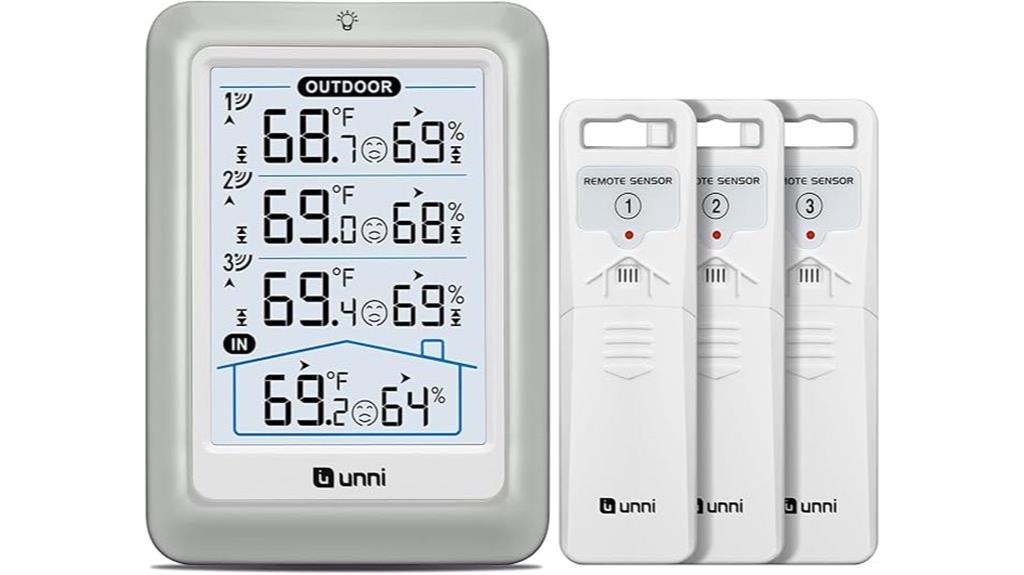
When managing a greenhouse, accurate monitoring of temperature and humidity is essential for plant health, and that’s where the Indoor Outdoor Wireless Thermometer with Digital Hygrometer shines. This device features a 4.5-inch digital display that shows real-time readings for both indoor and outdoor conditions. With a temperature range from -40ºF to 158ºF and humidity levels between 20% and 95%, it gives reliable data. I appreciate its easy setup and good transmission range of up to 330 feet. Plus, the daily MAX/MIN records help me track changes effortlessly, ensuring my plants thrive in ideal conditions.
Best For: This product is best for greenhouse owners and gardening enthusiasts who require precise temperature and humidity monitoring to ensure optimal plant growth.
Pros:
- Easy setup with quick syncing of sensors.
- Accurate readings with a good transmission range of up to 330 feet.
- Daily MAX/MIN records help track changes effortlessly.
Cons:
- Display visibility can be an issue at off-angles.
- Limited customization options for comfort indicator thresholds.
- Comfort indicator may not be useful for all users due to fixed humidity thresholds.
Greenhouse Automatic Window Opener with Solar Power Sensor
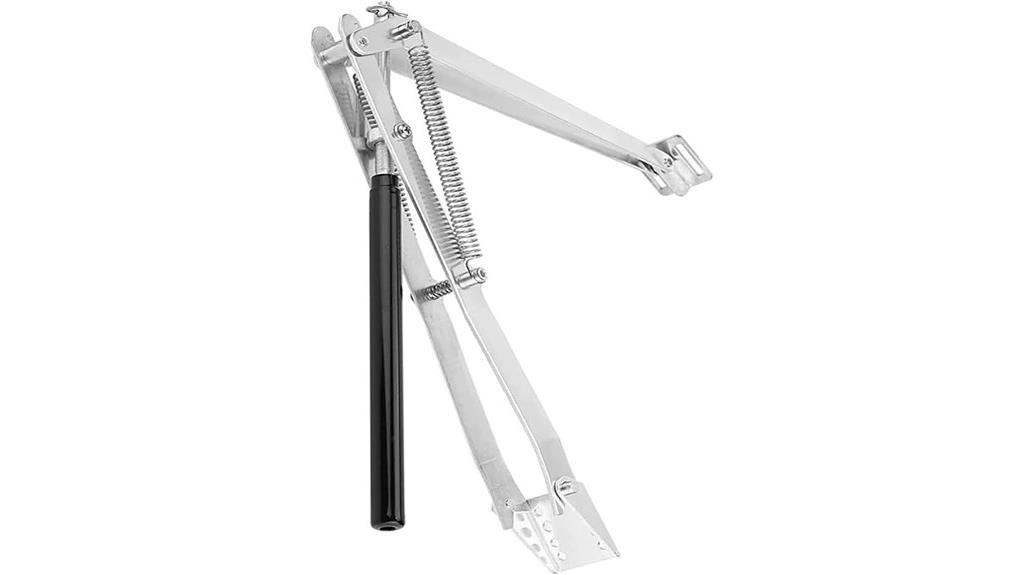
Imagine enjoying a thriving greenhouse without the constant worry of manual ventilation; that’s exactly what a greenhouse automatic window opener with a solar power sensor can offer. This clever device operates without electricity, using temperature fluctuations to open and close windows autonomously. With its dual spring design, it lifts up to 15 lbs, guaranteeing durability. Installation is straightforward, usually taking around 10 minutes, though some users might need minor adjustments. I’ve found it effectively maintains ideal conditions, especially during vacations. Just verify proper installation for the best performance, and you’ll enjoy a well-ventilated greenhouse effortlessly!
Best For: Greenhouse owners looking for an automated, reliable solution for temperature control and ventilation without the need for electricity.
Pros:
- Durable Design: Made from high-quality aluminum alloy, ensuring long-lasting use and resistance to rust.
- Ease of Use: Automatically opens and closes windows based on temperature, reducing the need for manual intervention.
- Quick Installation: Generally takes around 10 minutes to install, making it accessible for most users.
Cons:
- Installation Challenges: Some users may face alignment issues requiring additional adjustments or drilling.
- Durability Concerns: Performance may vary in strong winds, potentially affecting reliability.
- Return Policies: Users should be cautious of return policies, especially for defective items, to avoid unexpected costs.
3-Pack Mini Hygrometer & Thermometer for Indoor and Outdoor Use
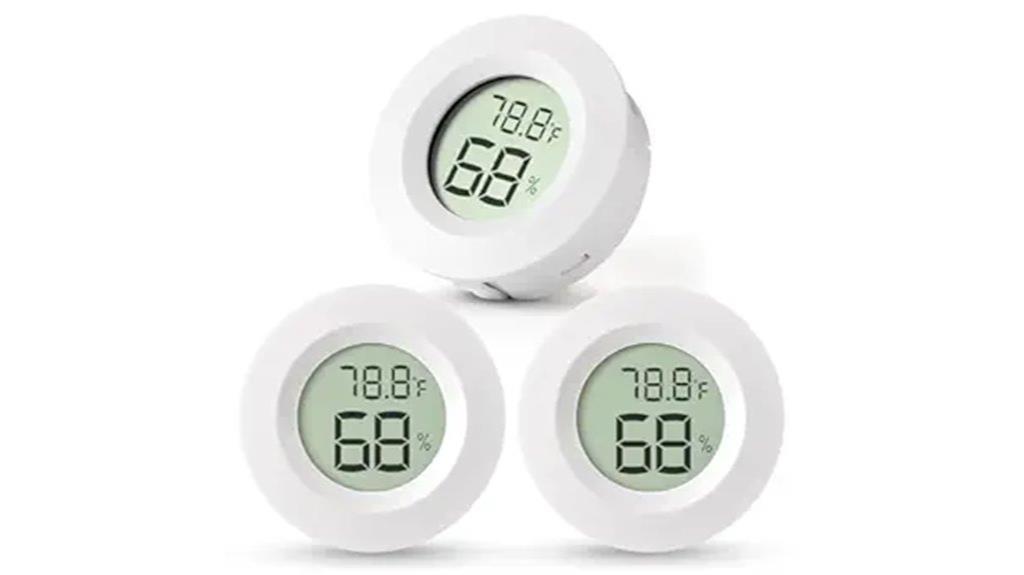
The 3-Pack Mini Hygrometer & Thermometer stands out as an essential tool for anyone looking to optimize their greenhouse environment. These compact devices are portable and can be easily pasted on walls or placed in containers. With a quick response time, they update measurements every ten seconds, ensuring you’re always informed about the humidity and temperature. They cover a humidity range of 20% to 99% and temperatures from 14℉ to 140℉, providing reliable data for your plants. Plus, they come with batteries and adhesive strips, making setup effortless. Their versatility makes them perfect for various indoor and outdoor applications.
Best For: Gardeners and plant enthusiasts looking to monitor and optimize their greenhouse conditions.
Pros:
- Compact and portable design allows for easy placement in various locations, both indoor and outdoor.
- Fast response time with updates every ten seconds ensures real-time monitoring of humidity and temperature.
- Versatile applications make them suitable for a range of uses, including home, office, and reptile care.
Cons:
- Some users reported inconsistent readings which may affect reliability.
- Limited accuracy in extreme conditions, with a ±5% RH and ±1.8℉ (±1℃) margin.
- Small size may not be suitable for those who prefer larger, more visible devices.
YoLink Smart Wireless Temperature & Humidity Sensor
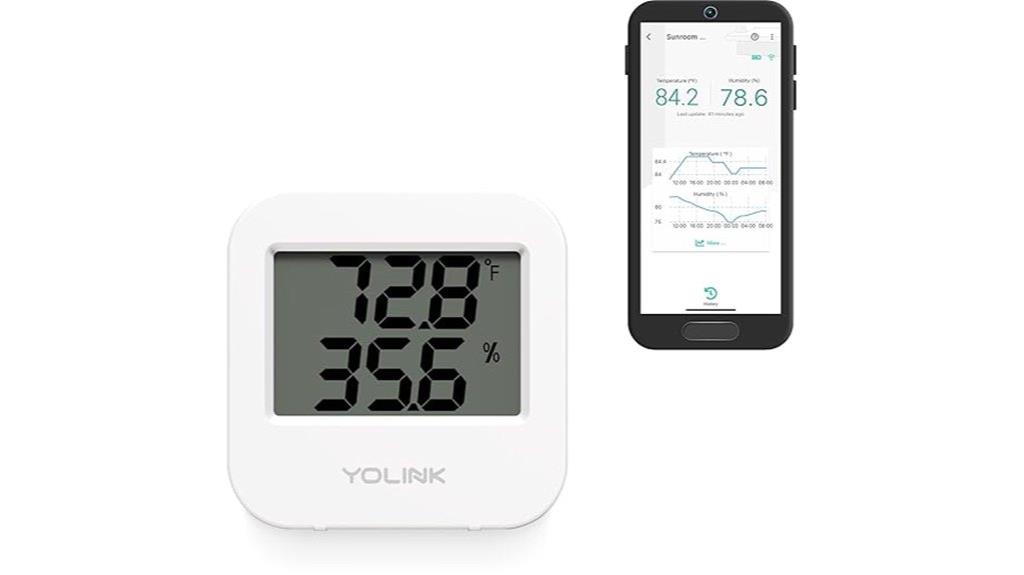
For greenhouse enthusiasts looking to optimize their environment, the YoLink Smart Wireless Temperature & Humidity Sensor stands out with its LoRa-based long-range connectivity. This device operates without WiFi congestion, making it perfect for various settings, including greenhouses. I appreciate its simple setup process; just install the app, connect the hub, and add sensors. The alerts, customizable for temperature thresholds, keep me informed via text or email. With a battery life exceeding two years, I can trust it won’t fail me. Plus, its app functionality allows me to track conditions over time, ensuring my plants thrive.
Best For: Greenhouse enthusiasts and anyone looking to monitor temperature and humidity without WiFi congestion.
Pros:
- Easy setup process with a user-friendly app for monitoring.
- Long battery life of over two years, ensuring reliable performance.
- Customizable alerts keep users informed of temperature and humidity changes.
Cons:
- Initial hub setup may pose challenges for some users.
- SMS alerts are limited to 15 per month, which may not be sufficient for heavy users.
- Requires an Ethernet connection for optimal hub setup, which may not be convenient for all users.
WiFi Room Thermometer Hygrometer Smart Temperature Sensor (3 Pack)
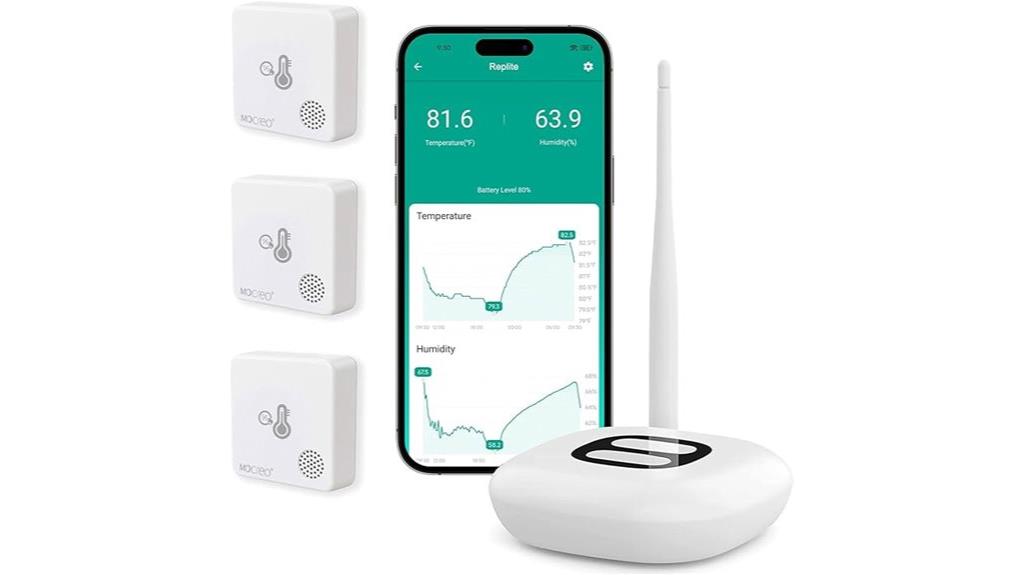
Looking for a reliable way to monitor temperature and humidity in your greenhouse? The WiFi Room Thermometer Hygrometer Smart Temperature Sensor (3 Pack) is an excellent choice. With the MOCREO app, I can easily track conditions 24/7. The sensors are accurate, covering a temperature range of -4°F to 140°F and humidity from 0% to 100%. I appreciate the alert options—email, app notifications, and a loud hub alarm. Plus, the battery lasts up to two years. Although the initial setup can be tricky, once it’s up and running, it’s a game-changer for maintaining ideal growing conditions.
Best For: Gardeners and greenhouse owners looking for reliable, real-time temperature and humidity monitoring.
Pros:
- Accurate monitoring with a wide temperature range of -4°F to 140°F and humidity from 0% to 100%.
- Multiple alert options including email, app notifications, and a loud hub alarm for immediate awareness.
- Long battery life of up to two years, reducing the need for frequent replacements.
Cons:
- Initial setup may be challenging and not intuitive for all users.
- Lack of alerts for sensor disconnection, which could be a useful feature for future updates.
- Signal strength issues can occur in metal-enclosed areas, affecting performance.
2-Pack WiFi Temperature Humidity Sensor for Home and Greenhouse
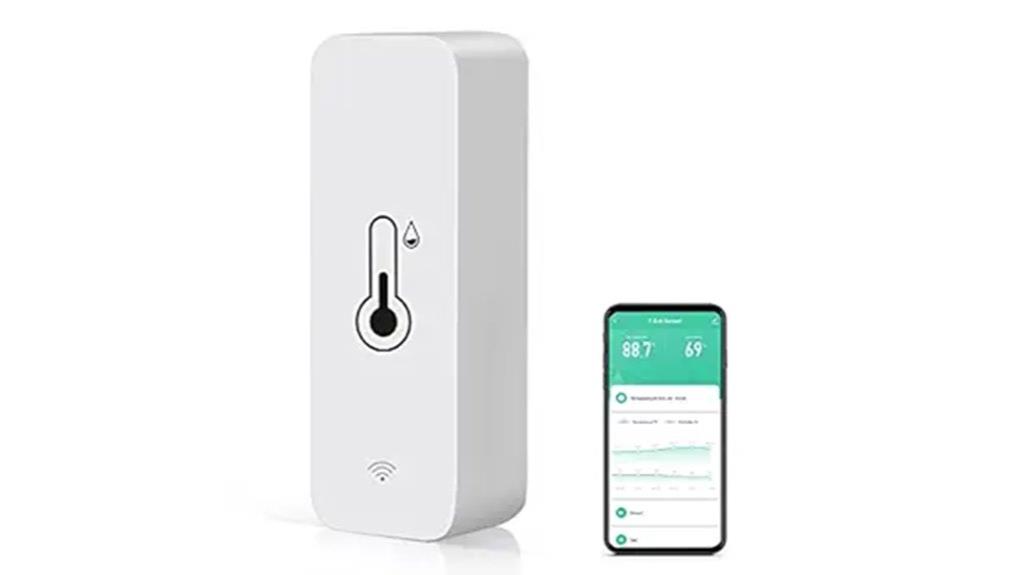
If you want to optimize your greenhouse environment, the 2-Pack WiFi Temperature Humidity Sensor stands out as an excellent choice. These sensors connect via 2.4 GHz WiFi, allowing me to monitor temperature and humidity remotely through a free app. I love that I can receive alerts when conditions exceed my set limits, ensuring my plants thrive. The compact design fits perfectly in small spaces, and I appreciate the voice control compatibility with Amazon Alexa and Google Home. Plus, with a battery life of over a year, these sensors are both reliable and low-maintenance—perfect for any greenhouse enthusiast!
Best For: Greenhouse enthusiasts and home gardeners looking to optimize their plant care through remote monitoring of temperature and humidity.
Pros:
- Compact design makes it suitable for small spaces like potted plants and cigar humidors.
- Remote alerts notify users when temperature or humidity levels exceed preset limits, ensuring optimal conditions.
- Voice control compatibility with Amazon Alexa and Google Home enhances convenience for smart home users.
Cons:
- Some users have reported connectivity issues with the app, which may affect real-time monitoring.
- Programming instructions may not be as clear, leading to potential confusion during setup.
- Limited functionality in environments with poor WiFi signal, impacting performance.
AC Infinity CLOUDCOM B1 Temperature Humidity Smart Hygrometer
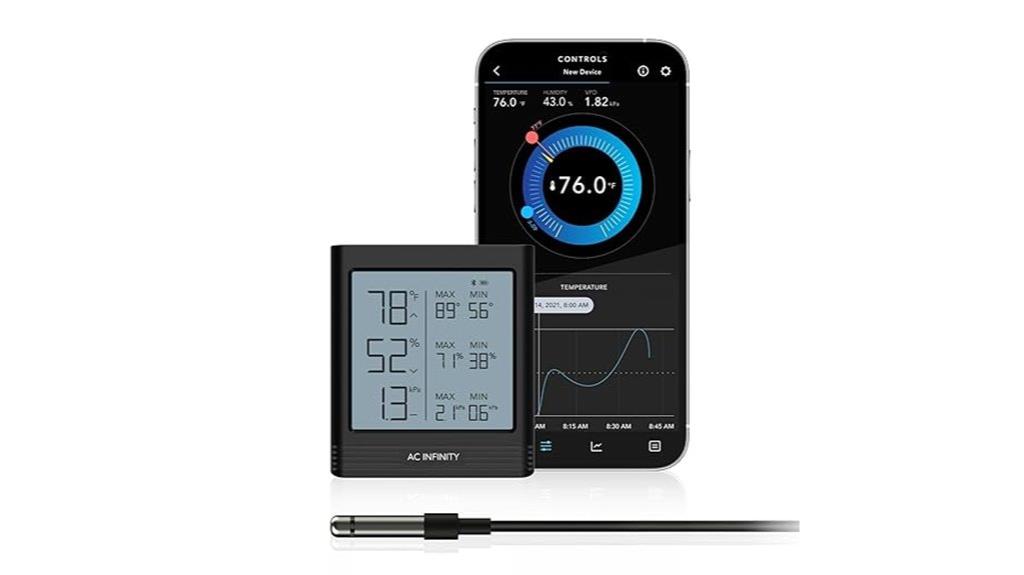
The AC Infinity CLOUDCOM B1 Temperature Humidity Smart Hygrometer stands out for its Bluetooth connectivity, making it an ideal choice for greenhouse enthusiasts who want remote monitoring capabilities. I found it easy to set up—just insert the batteries, download the app, and calibrate. The readings are impressively accurate, although I recommend double-checking against other instruments occasionally. The app’s user-friendly interface lets me access data quickly. However, I wish it had WiFi support for broader connectivity. Overall, despite minor limitations, I appreciate its compact size and effectiveness for monitoring my greenhouse environment efficiently. It’s definitely worth considering!
Best For: Greenhouse enthusiasts and hobbyists looking for an affordable and effective way to monitor temperature and humidity remotely.
Pros:
- User-friendly app allows for quick access to temperature and humidity data.
- Compact size makes it ideal for tight spaces like grow tents or small rooms.
- Accurate readings compared to traditional analog devices, with the ability to set adjustment offsets.
Cons:
- Lacks WiFi capability, limiting connectivity options compared to other devices.
- Some users experienced initial pairing issues and Bluetooth connectivity limitations when outside their home.
- The device does not trigger actions on the AC Infinity controller 69, limiting automation integration.
Indoor Outdoor Thermometer Hygrometer Wireless Weather Station
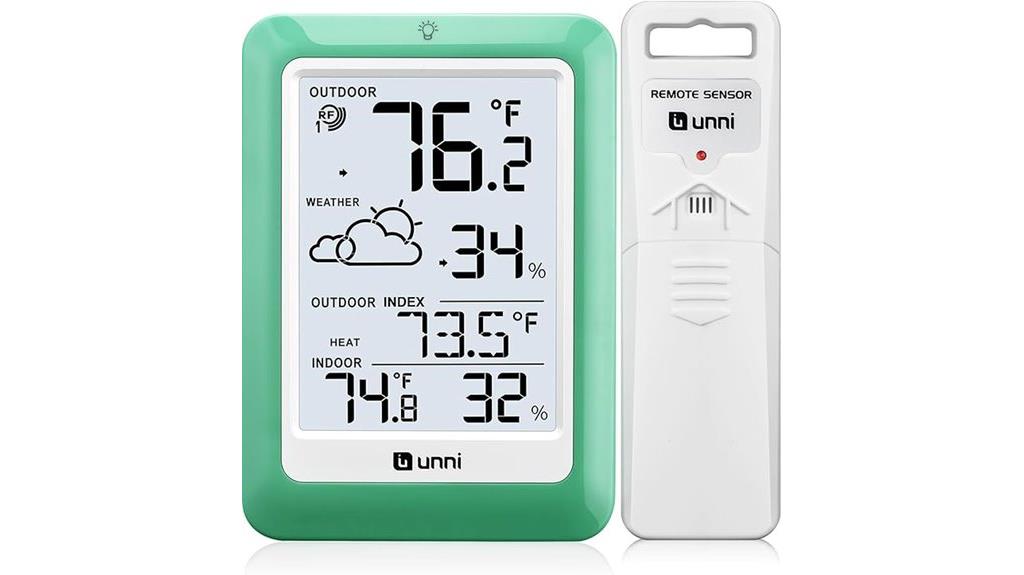
For greenhouse enthusiasts and caretakers, the Indoor Outdoor Thermometer Hygrometer Wireless Weather Station stands out as an essential tool for maintaining ideal growing conditions. With its Swiss-made high-precision sensor, it delivers accurate temperature readings from -58ºF to 158ºF and humidity levels from 1% to 99%. The remote sensor has a range of 330 ft, making it versatile for various setups. I love the large, clear display, which is easy to read even in low light. Plus, it updates data every 30 seconds, ensuring I always have the latest information. It’s truly a game-changer for monitoring my greenhouse environment!
Best For: Greenhouse enthusiasts and caretakers looking to maintain ideal growing conditions with precise temperature and humidity monitoring.
Pros:
- Accurate temperature and humidity readings with a Swiss-made high-precision sensor.
- Large, clear backlit display that is easy to read, even in low light conditions.
- Remote sensor with a 330 ft range, allowing versatile placement for various setups.
Cons:
- Some users desire additional features like a continuous backlight and historical records of min/max temperatures.
- Weather prediction accuracy may not always meet expectations.
- Lack of a clock feature may be inconvenient for some users.
ThermoPro Wireless Indoor Outdoor Thermometer
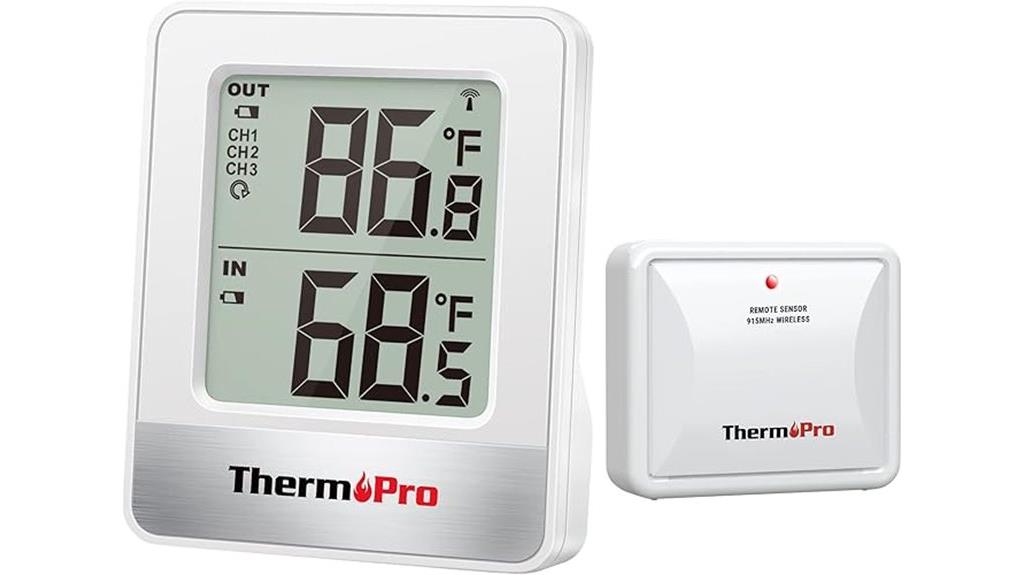
Looking to monitor temperature fluctuations in your greenhouse effectively? I’ve found the ThermoPro Wireless Indoor Outdoor Thermometer to be an excellent choice. With a range of up to 500 feet, it supports three sensors, making it easy to keep tabs on multiple areas like your garden or cellar. The rainproof design guarantees reliability, and the accuracy of +/-2°F is impressive. Setup is a breeze, and while the display is compact, the large digits are easy to read. Just keep an eye on battery life, as some users have reported needing replacements sooner than expected. Overall, it’s a solid investment for greenhouse management!
Best For: Those looking for an accurate and reliable temperature monitoring solution for indoor and outdoor environments, such as greenhouses, gardens, and cellars.
Pros:
- Supports monitoring up to three different locations with a range of 500FT.
- IPX4 rainproof design ensures functionality in various weather conditions.
- Easy setup and installation with large, easy-to-read digits on the display.
Cons:
- Some users report shorter battery life than expected, particularly with rechargeable options.
- Display size may be considered small, making it harder to read from a distance.
- Durability concerns have been noted, with some units failing after the return period.
2-Pack Mini Digital Thermometer Hygrometer for Indoor Room
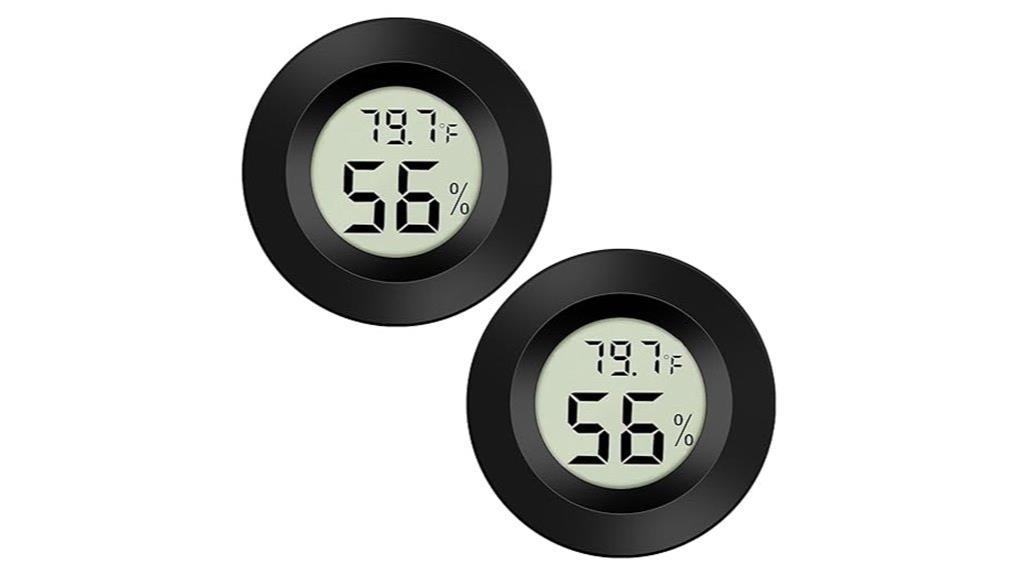
Monitoring temperature and humidity is essential for anyone trying to maintain ideal conditions in a greenhouse or indoor garden. That’s why I love the 2-Pack Mini Digital Thermometer Hygrometer. It’s perfect for both indoor and outdoor settings, providing accurate readings every 10 seconds. With a temperature range of -50℃ to +70℃ and humidity from 20% to 90% RH, it’s versatile enough for various environments—whether it’s a baby room or a reptile terrarium. The compact design fits easily in tight spaces, though the non-backlit display can be a bit tricky in dim light. Overall, it’s a reliable, affordable tool for monitoring conditions effectively.
Best For: Anyone looking to maintain optimal temperature and humidity levels in various indoor and outdoor environments, including homes, greenhouses, and pet habitats.
Pros:
- Accurate readings updated every 10 seconds, ensuring timely monitoring.
- Compact design allows for easy placement in tight spaces.
- Versatile applications suitable for a range of environments, from baby rooms to reptile terrariums.
Cons:
- Non-backlit display may be difficult to read in low light conditions.
- Some users reported minor inaccuracies between units.
- Lower humidity limit of 20% may not be suitable for all applications.
12 Pack Mini Digital Hygrometer with Temperature and Humidity Monitor
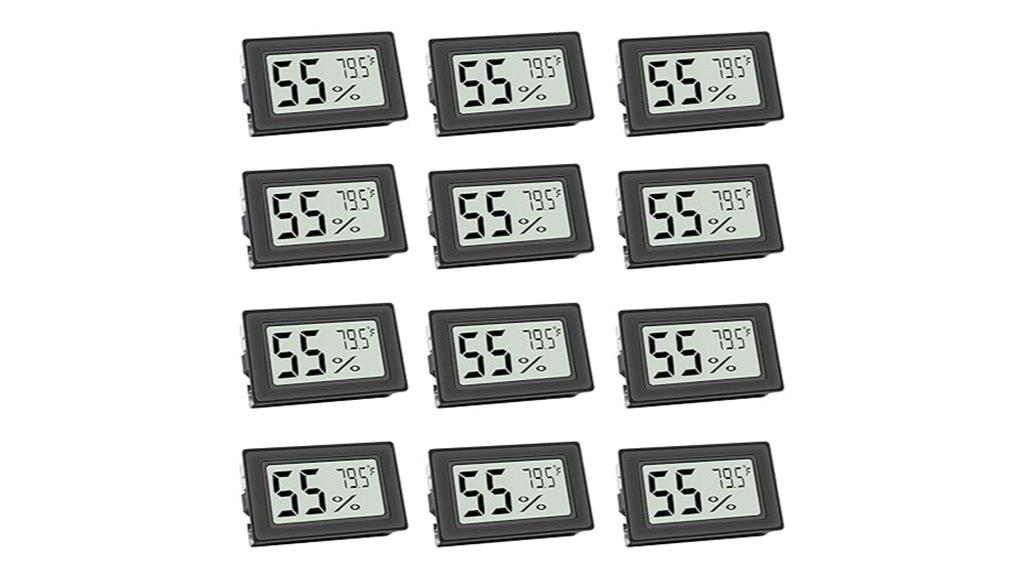
The 12 Pack Mini Digital Hygrometer with Temperature and Humidity Monitor is an excellent choice for gardeners and hobbyists who need a compact and efficient way to keep tabs on their greenhouse environment. With its high-precision sensor, it measures temperatures from -58℉ to 158℉ and humidity levels from 10% to 99% RH. I love how easy it is to read the display even in dim light. While I’ve noticed some variations in humidity readings, it’s perfect for basic monitoring in tight spaces. Just remember, if you need precise measurements, you might want to cross-reference with more reliable sensors.
Best For: Gardeners and hobbyists who need an efficient and compact solution for basic indoor climate monitoring.
Pros:
- Compact design makes it suitable for tight spaces like jars and grow tents.
- Clear digital display ensures easy reading in low-light environments.
- Comes with spare batteries, offering convenience for prolonged use.
Cons:
- Some users report discrepancies in humidity readings, impacting accuracy.
- Not recommended for applications requiring precise humidity measurements.
- Variability in readings can lead to dissatisfaction for those needing reliable data.
Factors to Consider When Choosing Sensor Technology for Greenhouses

When I consider sensor technology for my greenhouse, several key factors come to mind. Accuracy and precision are essential, but I also need to think about connectivity options and data logging capabilities. Plus, I can’t forget about power source considerations and how well the sensors will perform in my specific environment.
Accuracy and Precision
Accuracy and precision are fundamental in maintaining the ideal conditions for greenhouse plants. I’ve learned that even minor fluctuations in temperature and humidity can have significant impacts on plant growth and health. To guarantee reliable readings, I always look for sensors with an accuracy of ±1% relative humidity and ±2°F for temperature. Calibration features that allow for adjustments in increments of 0.1°F or % enhance precision, making certain the sensor readings align closely with actual conditions. Additionally, I prefer sensors with quick refresh rates, like every 2 seconds, for real-time monitoring. Consistency across multiple units is essential, as discrepancies can lead to incorrect assessments and affect my plant care strategies. Choosing the right technology is critical for ideal growth.
Connectivity Options
Maintaining accurate readings is just the beginning; connectivity options are equally important for effectively managing greenhouse conditions. I’ve found that choosing the right connectivity can greatly enhance my greenhouse operations. Bluetooth works well for smaller spaces, offering a reliable range of about 100 meters, perfect for direct monitoring. On the other hand, WiFi-enabled sensors let me access real-time data remotely, receiving alerts directly on my mobile device. For larger setups, LoRa technology stands out; it can transmit data over distances exceeding 1 kilometer, which is great for avoiding WiFi congestion. Plus, LoRa’s low-power consumption means longer battery life, an essential factor when I’m managing multiple sensors. Ultimately, the right connectivity guarantees seamless monitoring and control in my greenhouse.
Data Logging Capabilities
Choosing the right data logging capabilities in greenhouse sensors can make a significant difference in how I manage my plants. With sensors that record temperature and humidity over time, I gain valuable insights into environmental trends. Many of these devices can store data for up to 20 days or even offer two years of historical data for easy export in formats like CSV. Customizable logging intervals let me choose how frequently data is recorded, sometimes as short as every 2 seconds. Plus, advanced sensors with cloud-based storage provide unlimited data retention and easy access via dedicated apps. Analyzing this logged data helps me make informed decisions about climate control, optimizing conditions for plant growth while preventing issues like mold or crop failure.
Power Source Considerations
Understanding the data logging capabilities of greenhouse sensors is just the beginning; I also need to contemplate their power sources. I can choose between battery-operated devices, which last up to two years but may drain quickly under heavy use or extreme conditions, and wired models that guarantee continuous operation. Solar-powered sensors offer a sustainable alternative, but they need adequate sunlight. When deciding, I must think about the installation location; battery-operated sensors are great for hard-to-reach areas, but I risk downtime when replacing batteries. Ultimately, the power source I select will impact the sensor’s reliability—wired options typically provide uninterrupted data logging, while battery-powered devices can falter during battery changes. Balancing convenience and reliability is vital for my greenhouse’s success.
Environmental Suitability
When selecting sensor technology for my greenhouse, I must prioritize environmental suitability to guarantee peak performance. I look for devices that function effectively across a wide temperature range, from -40°F to 158°F, accommodating fluctuating conditions. Humidity sensors are vital, needing to measure a range of 20% to 95% RH to prevent mold growth in sensitive plants. High accuracy is essential, ideally ±1% for humidity and ±2°F for temperature, securing reliable monitoring. I also consider wireless connectivity options like Bluetooth or WiFi for real-time data access and timely adjustments. Finally, I check the battery life, aiming for sensors that last 1-2 years under normal conditions to minimize maintenance and secure continuous monitoring.
Frequently Asked Questions
How Do I Install Greenhouse Sensor Technologies Effectively?
When I install greenhouse sensor technologies, I start by mapping out the layout of my space. I guarantee sensors are placed where they can accurately monitor temperature, humidity, and light levels. I connect them to a reliable data management system for real-time insights. I also regularly check their calibration to maintain accuracy. Finally, I make sure to follow the manufacturer’s guidelines to guarantee everything runs smoothly and efficiently.
What Is the Average Lifespan of Greenhouse Sensors?
When I think about the average lifespan of greenhouse sensors, it typically ranges from 3 to 10 years, depending on the type and quality. I’ve noticed that environmental factors like humidity and temperature can affect their durability. Regular maintenance and calibration can help extend their life. If I choose high-quality sensors and take good care of them, I can often get the most value and longevity from my investment.
Can Sensors Be Integrated With Greenhouse Automation Systems?
Absolutely, sensors can be integrated with greenhouse automation systems! I’ve seen how this combination enhances efficiency and control. By connecting sensors to an automation system, I can monitor and adjust environmental conditions in real-time, ensuring ideal growth. For instance, when humidity levels rise, the system can automatically activate ventilation. This integration not only saves time but also helps maintain the perfect environment for my plants to thrive. It’s a game changer!
How Do I Maintain and Calibrate My Sensors?
I remember the sinking feeling when I realized my sensors weren’t reading accurately. To maintain and calibrate them, I first check for any dirt or debris that might interfere. Regularly, I compare their readings with a trusted reference, adjusting as needed. I also keep track of any changes in performance, ensuring I stay ahead of any issues. By dedicating time to this, I can keep my data reliable and my plants thriving.
Are There Any Compatibility Issues With Different Sensor Brands?
I’ve encountered compatibility issues with different sensor brands while setting up my system. Sometimes, sensors from one manufacturer don’t seamlessly integrate with those from another. I recommend checking the specifications and compatibility lists before purchasing. It’s saved me a lot of headaches! Additionally, using a central hub that supports multiple brands can help mitigate these issues. Always do a bit of research to guarantee everything works together smoothly.
Conclusion
In the ever-evolving dance of greenhouse cultivation, choosing the right sensor technology can feel like finding the perfect partner. With the right tools, you can fine-tune your growing environment, ensuring your plants thrive in a harmonious symphony of temperature and humidity. As you explore the options, remember that each sensor is a note in your garden’s melody, helping you cultivate not just plants, but a lush paradise where nature’s beauty can truly flourish. Happy growing!

